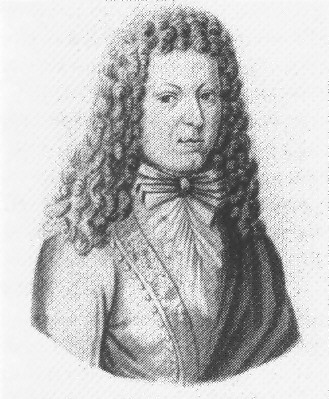<Back to Index>
- Aviation Pioneer Anton Herman Gerard "Anthony" Fokker, 1890
- Composer Johann Kuhnau, 1660
- Dictator of Bolivia Alfredo Ovando Candía, 1918
PAGE SPONSOR

Johann Kuhnau (6 April 1660 – 5 June 1722) was a German composer, organist and harpsichordist. He is considered the greatest German clavier composer prior to Johann Sebastian Bach. Kuhnau was born in Geising. He preceded Johann Sebastian Bach as cantor of the Thomaskirche (St Thomas Church) in Leipzig, directing the Thomanerchor from 1701 to 1722. There Kuhnau taught Johann David Heinichen and Christoph Graupner, both of whom were to become composers. He remained there until his death.
In
addition to his native German, Kuhnau was fluent in French and Italian,
and left translations from Hebrew, Greek, and Latin as well. Kuhnau
also studied law, attaining the rank of advocate. In addition to
composition, much of his time was spent as a lawyer, a poet, and a
non-fiction author. Kuhnau is credited as the inventor of the keyboard sonata, elevating the form from simple dance tunes. His Sonata, Eine Sonata aus dem B, is written in three movements, anticipating the Sonata - allegro form. It is the first known keyboard Sonata in existence. Kuhnau's secular vocal music is lost, but many of his sacred works survive,
including cantatas, motets, and four sets of keyboard pieces. Kuhnau was born in Geising, which was a city in the Saxony area of Germany.
In his young age of life, little Johann and his family were religious
German Christians; as forth bible study, musical compositions about the
lord, and more Christian activities were contributed in the family
lifeline. At 2,3, or 4 years old, it was time for Johann to practice the piano, as of in the 16th century, the clavichord, of which's strings were plucked, just like the harpsichord, plus each keyboard (clavichord (can be also known as the 'clavi')
and harpsichord) were both known as claviers. Johann practiced
clavichord so much, he started to write compositions dealing with
stories and events in the Holy Bible. When he was 9 years
old, he qualified, and eventually auditioned, in events happening in Kreuzscule, in Dresden,
being in and studying choir and other different types of music with 2
teachers named Hering and Bental. His abilities increased more and
more; it started when he became attracted by and strongly interested in
the music of the Kapellmeister, Vincenzo Albrici. With him, Johann was kept as a guest for music practices. During 1680, an unexpected and dangerous outbreak of a contagious disease erupted in Dresden, where
Kuhnau was being taught in his teenage years as a Kreuzscule
student. As a result, he left the city, kissed his
surviving soo-to-become-ill relatives good-bye, and emigrated to Zittau, where he could teach with his Internal Assistant (IA) Edlmann. Motets,
choirs, compositions - he taught these 16th century subjects in the
school he was qualified in so much, that he was brought in many of
Zittau's churches. His native German was also added to French and
Italian, and left translations from Hebrew, Greek, and Latin as well.
Kuhnau also studied law, attaining the rank of advocate. In addition to
composition, much of his time was spent as a lawyer, a poet, and a
non-fiction author. He preceded Johann Sebastian Bach as Cantor of the Thomaskirche (St Thomas Church) in Leipzig, directing the Thomanerchor from 1701 to 1722. There Kuhnau taught Johann David Heinichen and Christoph Graupner,
both of whom were to become composers. Unfortunately, his life of
happiness began to decrease. His 2 sons and daughter passed
away and, what was probably the cause, the sickness probably got to him
slowly. He died
in June 5, 1722, in Thomasschule, where he was succeeded in his teaching duties by the famous 17th century composer, Johann Sebastian Bach. Kuhnau
wrote compositions about the stories and events in the Holy Bible. He
created compositions of Christianity, including, The Marriage of David,
Gideon, the Tomb of Jacob, and one exclusively for organ of what is
called Der todtkranke und wieder gesunde Hiskias (The todtkranke and
again healthy Hiskias). Kuhnau is credited as the inventor of the
keyboard sonata, elevating the form from simple dance tunes. His Sonata, Eine Sonata aus dem B, is written in three movements, anticipating the Sonata - allegro form. It is the first known keyboard Sonata in existence. Kuhnau's
secular vocal music is lost, but many of his sacred works survive,
including cantatas, motets, and four sets of keyboard pieces. In recent years, it has been suggested that Kuhnau may have written the "Christmas cantata" formerly attributed to Bach as BWV 142. Since
musicologists no longer believe Bach to have written BWV 142, it is now
performed and recorded much less frequently than formerly.